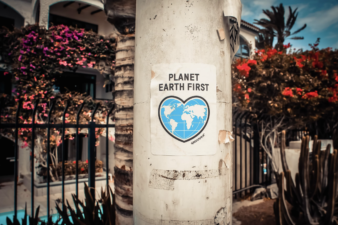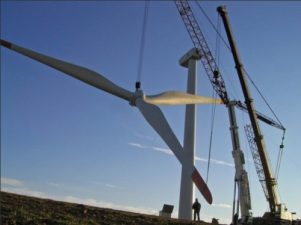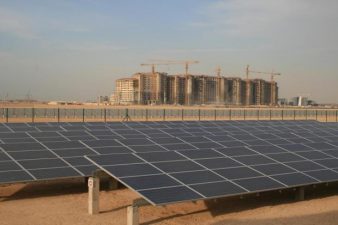The American gas giant Air Products & Chemicals announced this week that it will build the world’s largest green hydrogen plant in Saudi Arabia. It will be powered by 4 gigawatts of wind and solar power and the $5 billion USD project will be jointly owned by Air Products, Saudi Arabia’s ACWA Power and Neom, a new mega-city planned near Saudi Arabia’s borders with Egypt and Jordan. You can see the vision in the image above, and the actual site in an image below.
The green ammonia made at the megaplant will made for export to global markets. And the technology used in the project will include the innovative integration of over four gigawatts of renewable power from solar, wind and storage; production of 650 tons per day of hydrogen by electrolysis using thyssenkrupp technology; production of nitrogen by air separation using Air Products technology; and production of 1.2 million tons per year of green ammonia using Haldor Topsoe technology. The project is scheduled to be onstream, or online and working, by 2025.
The new and yet to be built city of Neom has some serious objectionable plans (and a murder of a local Bedouin activist to deal with), with the ideas from it definitely borrowed from but very askew with the Solarpunk movement or environmentalists in general.
After the Saudi Arabian journalist was brutally executed at the Saudi Arabian embassy in Turkey in 2018 many American and UK companies pulled out their deals including Google-owned Alphabet (working with Neom) and Richard Branson of Virgin.
Can we forgive Saudi Arabia as it plans to go green? The completed green hydrogen plant is expected to produce 650 tons of green hydrogen daily, which is about enough to run around 20,000 hydrogen-fueled buses, Air Products said in a press release.
“Harnessing the unique profile of Neom’s sun and wind to convert water to hydrogen, this project will yield a totally clean source of energy on a massive scale and will save the world over three million tons of CO2 emissions annually and eliminate smog-forming emissions and other pollutants from the equivalent of over 700,000 cars,” said Seifi Ghasemi, CEO for Air Products in a press statement.

Location for proposed Neom City, on the Red Sea.
Global interest in green hydrogen is rising among oil and gas firms and continents like Europe want to make green hydrogen part of its Green Deal, with an EU-wide green hydrogen policy to be published sometime this month.
“We cannot electrify everything,” said WindEurope CEO Giles Dickson. “Some industrial processes and heavy transport will have to run on gas. And renewable hydrogen is the best gas. It is completely clean. It will be affordable with renewables being so cheap now.”

Hyzon, a hydrogen fuelled bus
Pennsylvania-based Air Products says it is the world’s largest producer of hydrogen and a leader in the liquefied natural gas field technology and it has a trading value of about $60 billion on the New York Stock Exchange (NYSE: APD). The American international corporation sells gas and chemicals for industrial uses.
Saudi Arabia is investing in green hydrogen and renewable energy as a move to divest from oil, but also to woo the western world to the overly conservative and restrictive Saudi Arabian culture. The creators of the new city of Neom want to be able to host one million people from around the world every year. As we see with Middle East vision, often borrowed from Western values but put poorly executed, medga-cities like the zero-energy city Masdar don’t really work. The city is virtually a ghost town now – See The Ecotopia that Never Was.
But Neom, planned to include flying taxis, sparring dinosaurs, fake rain, fake moons, AI to monitor your every movement: “This is a pivotal moment for the development of Neom and a key element in Saudi Vision 2030 contributing to the Kingdom’s clean energy and circular carbon economy strategy,” Neom CEO Nadhmi Al Nasr said in a statement.
While green hydrogen is not yet competitive with hydrogen produced by natural gas, like green power made by solar or wind is not competitive with energy produced by natural gas or oil, I support the creation of premium energy and fuel products that are green and sustainable.
However, about the local Saudi Arabian infrastructure, maybe other solutions are in need of investment first:
Over on Greentech Media one reader comments:
“I personally think they’d be better off putting in more efficient desalination technologies and building more waste water treatment plants in their cities, and the plumbing to get the sewage from their various public buildings and hotels to those wastewater treatment plants. I think that would lower more emissions than putting up a massively inefficient and expensive hydrogen generation facility.
“Right now the Saudi‘s truck around a lot of human waste between a majority of their buildings and their waste water processing facilities, putting in plumbing would remove all of the trucks driving back-and-forth and idling for hours in line waiting to dump their waste, and consequent emissions.
“That would be a much better investment for the public good.”
Maybe there is a point: Consider the Burj Khalifa in Abu Dhabi, which trucks out human waste every day from the mega-tower. Read Where Does the Poo Go after you eat at one of the World’s Classiest Restaurants.
But I guess this is less of a social issue and more of investing in renewable energy. The cost of which is often debated. See Planet of the Humans, Michael Moore.
While I can debate the value of putting green energy into practice with endless Saudi oil money (I am in favor of greener fuel and renewable energy), I also agree with the above commenter that public good and local issues should come first. Maybe Saudi is better investing builds and green hydrogen plants actually close to the areas where the hydrogen gas will actually be used for public transport. Public transport in Saudi Arabia where the Prince’s falcons get private planes? Not so much. But again, I stand somewhere between the line of being an environmental activist and supporting the real world technologies that will advance our step toward zero energy fuels.
I am all up for a good debate, so feel free to comment below.




